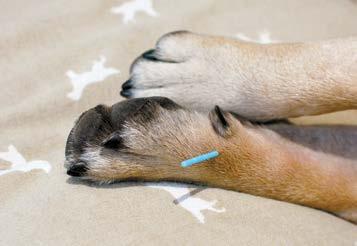
6 minute read
LOSE WEIGHT
sylvie bouchard/AdobeStock.com
Lose Weight Without Dieting How to Eat to Feel and Look Your Best
by April Thompson
One of the top New Year’s resolu- holiday indulgences, nutrition experts say tions is to lose weight, and to that it’s a great time to cultivate healthy, longend, millions of Americans go on term eating habits rather than unsustaina diet each year. As we look to reset after able diets that lead us in circles.
Celebrate Your Sexuality
Together we will: RECLAIM sexuality and sensuality CREATE sense of self love and self acceptance EMBRACE authentic sexual expression RELEASE trauma, shame and guilt AWAKEN sexual energy to bring renewed vitality to your life and your relationships

Michelle provides Sacred Sexuality, Love and Relationship Coaching helping women love, nourish and heal themselves.
Michelle Christine | www.SacredRose444.com michellechristine@sacredrose444.com | 215-345-1966 Sacred Rose located at The Unity Barn 4000 Sawmill Road | Doylestown, PA
“A ‘live it’ is better than a diet: small, manageable changes you can live with over time,” says Lisa Mallonee, a registered dietician and professor at the Texas A&M College of Dentistry, in Dallas. “People get focused on losing 15 pounds, but once they get to the finish line, they don’t have a plan for after and often end up regaining the weight.”
While navigating the labyrinth of nutrition information can be tough, eating better is actually simple, says David Katz, M.D., founder of both the YaleGriffin Prevention Research Center and the nonprofit True Health Initiative, and co-author of How to Eat: All Your Food and Diet Questions Answered. “There are two general shifts to make: first, to less processed foods, and second, to more plant-based foods,” says Katz.
In making such shifts, Mallonee suggests applying the 80/20 rule to food. “If 80 percent of the time you are making healthy choices, and the other 20 percent of the time you allow splurges, you’re less likely to feel deprived and revert to old ways.”
Katz agrees that small shifts are more likely to stick, in part because of our adaptable palates. “If you commit to improving your diet little by little, you will find that taste buds are adaptable fellas that will learn to love the foods they are with. For example, try something as simple as switching from regular soda to diet to seltzer to water over time.”
The good news for dieters with questions, suggests Katz, is there is no one superior diet. “You can have a highquality diet whether you are flexitarian, pescatarian or vegetarian, low-carb or high-carb,” he says.
For Jill Weisenberger, a registered dietitian nutritionist, in Yorktown, Virginia, and author of The Overworked Person’s Guide to Better Nutrition, a healthy diet comes down to three meals a day, each with a good source of protein and fiber. “When losing weight, it’s especially important to eat enough protein so you don’t lose muscle mass with the fat,” she says, suggesting a target of 25 to 35 grams of fiber a day,
achieved through a diverse diet that focuses on fruits, vegetables and legumes.
Katz, Mallonee and Weisenberger all caution against a diet like keto that restricts many nourishing foods only because they contain carbs. “There is no evidence of long-term safety or benefit of keto,” says Katz. “A truly keto diet cuts out a lot of highly nutritious foods like fruit, grains and beans, all associated with better health and longer life. I think a diet excluding these foods would be a colossal mistake.”
Weighing In
While it’s not healthy to obsess over numbers on the scale, it is important to understand the health risks of carrying extra weight, particularly around the middle. “Belly fat is a concern for co-morbidities like pre-diabetes, diabetes, increased blood pressure and even sleep apnea,” says Mallonee, stating that women should aim for a waist circumference of less than 35 inches and men of less than 40.
Katz advises that the effects of abdominal fat can vary. “Certain ethnicities are extremely vulnerable to excess weight around the middle, which can result in insulin resistance and metabolic mayhem. However, many people can gain considerable amounts of weight and show no metabolic effects,” he says, suggesting that a comprehensive health checkup can clear up any doubts.
Physiologically, it is hard to keep weight off, says Weisenberger, but people should not get discouraged if they fall short of their goals. “If you are overweight, you will get an enormous boost from the first 5 to 10 percent of weight loss—it’s much more important than that last 5 to 10 percent.”
While weight loss is an exercise in delayed gratification, the power of highquality food is immediate, advises Katz. “You can improve the quality of your immune response with a single meal. It’s the gift that keeps on giving, too, as those positive health benefits accumulate over time.”
Connect with Washington, D.C., freelance writer April Thompson at AprilWrites.com.
Slow Fashion
Mending to Extend the Life of Clothing
Globalization and cheap labor have lowered clothing prices so much that many people view garments as disposable—a phenomenon called “fast fashion”. Magazines and other influencers create demand for trendy items each season, inciting us to overfill our closets and toss last year’s fads, leading to a more than doubling of worldwide consumption since 2000. It’s a vicious cycle with a huge pollution footprint. The textile industry expels about 1.2 billion tons of CO2 per year.
According to the United Nations Environment Programme, the fashion industry produces 10 percent of humanity’s carbon emissions and 20 percent of global wastewater. Every second, the equivalent of one garbage truck of textiles is either landfilled or burned. Polyester, a petroleum-based plastic found in about 60 percent of garments, doesn’t break down in the ocean, where half a million tons of microfibers end up every year. It takes about 2,000 gallons of water to manufacture just one pair of jeans, and textile dyeing is the second largest polluter of waterways.
To embrace a more sustainable lifestyle, reject fast fashion; buy good-quality, longer-lasting garments; and mend them to prolong their useful life. Whether it’s reattaching a button, patching a worn sleeve or sewing a hem, mending is a way to love and care for clothing and reject the notion that new is always better.
Another option is to rely on a local seamstress or tailor to take care of mending needs. For the do-ityourselfer, there are many ingenious products available besides needle and thread to help complete simple repairs—iron-on patches, fusible interfacing, mending glue and tape— as well as helpful instructional online videos and sewing classes at local fabric stores. SewGuide.com is an excellent resource for step-by-step instructions and creative ideas.
Building upon the vintage-wear market, a new trend has emerged called visible mending. In the past, mended clothes might have been interpreted as exposing a family’s lack of funds or status, but today it’s a concept we proudly embrace. Mending a hole or tear with embroidery is a great way to add whimsy and creative expression. By incorporating colorful threads and fancy stitching techniques, as well as beads, decorative buttons, ribbons and appliqués, we can turn off-the-rack items into unique, wearable art. To cover stains, consider using fabric paint to add a pretty flower or bold political slogan.







